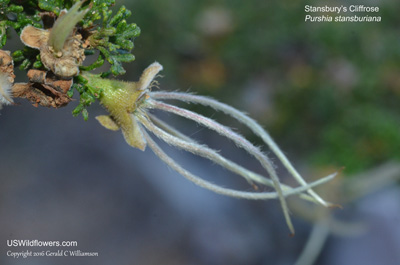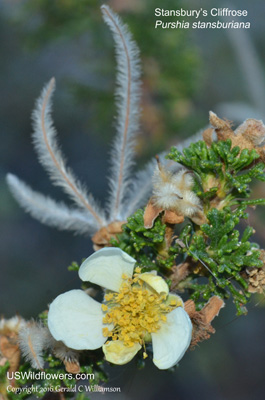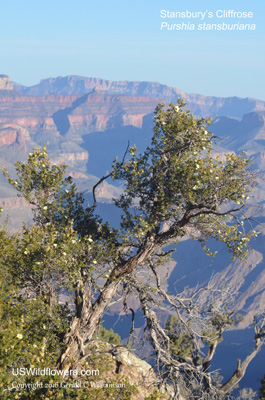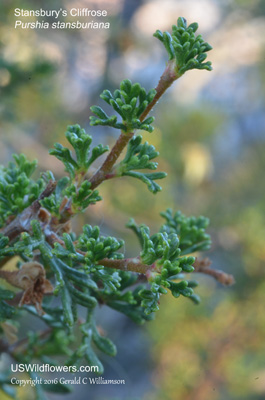Stansbury's Cliffrose, Cliff Rose, Quininebush - Purshia stansburiana
|
Purshia stansburiana - Stansbury's Cliffrose, Cliff Rose, Quininebush. It is hard to nail down a scientific name for Stansbury's Cliffrose, with the first disagreement among authorities being the spelling of the species epithet - stansburiana (more commonly used) or stansburyana (used by ITIS and some other authorities, more closely aligning with its namesake, American civil and topographical engineer Howard Stansbury, who died in 1863.) While it appears that virtually all authorities now agree that species within the genus Cowania (this plant was formerly known as Cowania stansburiana or Cowania stansburyana), are now properly classified within Purshia there is disagreement on whether it is a separate species, or should be classified as Purshia mexicana var. stansburyana; the latter is how it is classified by ITIS.
However you name it, this lovely plant grows in dry woodlands and desert scrub in the southwestern United States and northern Mexico. The photos on this page were taken along the south rim of the Grand Canyon in Coconino County, Arizona.
Found in:
AZ, CA, CO, ID, NM, NV, UT
Leave comments on Purshia stansburiana at this link. | 
Distribution of Purshia stansburiana in the United States and Canada:

Blue=Native; Grey=Introduced
Map from USDA Plants Database:
USDA, NRCS. 2017. The PLANTS Database (http://plants.usda.gov, 03 Apr 2025). National Plant Data Team, Greensboro, NC 27401-4901 USA.
Search Our Database: Enter any portion of the Scientific, Common Name, or both.
Do a general Google search of the entire site:
#ad
 Follow USWildflowers on Twitter
#ad
| | Site: Grand Canyon National Park South Rim, Coconino County, AZ Date: 2016-October-12 | Photographer: Gerald C. Williamson
Nikon D7000
Tamron SP 90MM f/2.8 AF Macro | | As with most members of Rosaceae, Purshia species, including P. stansburiana, have 5 petals. They are creamy-white or creamy-yellow. Like many in the family, it has a large number of stamens - Stansbury's Cliffrose have usually 60 to 90, but occasionally as many as 125. A nod to Jim Morefield, who pointed out to me that the number of styles is a diagnostic for the species, with P. stansburiana usually having 4 to 7 styles (most frequently 5), and the other species found in the Grand Canyon National Park having only 1 or 2. | | 
| | Site: Grand Canyon National Park South Rim, Coconino County, AZ Date: 2016-October-12 | Photographer: Gerald C Williamson
Nikon D7000 | | As the pollinated flower matures, the styles extend into long, feathery appendages to the ovary, with the developing achene at its base. These are wind-dispersed. | | Click on the photo for a larger image

| | Site: Grand Canyon National Park South Rim, Coconino County, AZ Date: 2016-October-12 | Photographer: Gerald C Williamson
Nikon D7000 | | | | Click on the photo for a larger image

| | Site: Grand Canyon National Park South Rim, Coconino County, AZ Date: 2016-October-12 | Photographer: Gerald C Williamson
Nikon D7000 | | Stansbury's Cliffrose is a shrub or small tree, usually less than 15 feet high, but sometimes as tall as 25 feet. I think this photograph demonstrates where the "Cliff" comes from in "Cliffrose." | | Click on the photo for a larger image

| | Site: Grand Canyon National Park South Rim, Coconino County, AZ Date: 2016-October-12 | Photographer: Gerald C Williamson
Nikon D7000 | | The leaves of Purshia stansburiana remind me of those of a cedar or juniper tree. The are small, dark green, with strongly revolute margins which give them a rounded appearance. They usually have 5 lobes, but may have as few as 3, and as many as 7. | | Click on the photo for a larger image

|
References used for identification and information:
|
|
| |
| #ad
|
|







